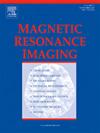基于APT影像和IVIM-DWI直方图的直肠腺癌病理特征与预后因素的相关性研究。
IF 2
4区 医学
Q2 RADIOLOGY, NUCLEAR MEDICINE & MEDICAL IMAGING
引用次数: 0
摘要
目的:探讨酰胺质子转移(APT)成像和体素内非相干运动(IVIM)直方图参数对直肠腺癌病理预后因素(淋巴结转移和血管侵犯)的预测价值。此外,本研究通过组合模型比较了这些参数的诊断性能。方法:本研究纳入42例经病理证实的直肠腺癌患者。测定原发性直肠癌的APT信号强度(APTSI)。对IVIM图像进行后处理,生成纯扩散系数(D)、伪扩散系数(D*)、灌注分数(f)的定量参数图。进行直方图分析,获得各参数的最小、最大、均值、标准差、方差、中位数、第10和第90百分位(以后分别为第10和第90百分位)、偏度、峰度和熵。术后病理结果包括T分期、淋巴结N分期、周围神经及淋巴血管浸润。结果:有无淋巴结转移(LNM)患者的D、D*直方图差异有统计学意义(P .05)。结合90度、峰度、熵和D*最大值的联合模型诊断直肠腺癌LNM的曲线下面积(AUC)为0.796。结合D值的均值、中位数、第10位、第90位、偏度、峰度、熵的联合模型诊断直肠腺癌淋巴血管浸润的AUC值为0.821。结论:IVIM直方图参数(如D的第90百分位、峰度和熵)对直肠腺癌的LNM和血管侵犯有重要的诊断价值。相比之下,APTSI与这些预后因素无显著相关性。这些发现强调了IVIM成像作为直肠腺癌患者术前风险分层的无创工具的潜力。重点:IVIM直方图参数有助于区分直肠腺癌的LNM和淋巴血管浸润。不同TN分期、侵犯周围神经、侵犯血管的直肠腺癌患者APTSI无明显差异。本文章由计算机程序翻译,如有差异,请以英文原文为准。
Correlation of pathologic features and prognostic factors in rectal adenocarcinoma based on APT imaging and IVIM-DWI histogram
Objective
This study aimed to evaluate the effectiveness of amide proton transfer (APT) imaging and intravoxel incoherent motion (IVIM) histogram parameters in predicting pathologic prognostic factors (lymph node metastasis and vascular invasion) in rectal adenocarcinoma. Additionally, the study compared the diagnostic performance of these parameters through combined models.
Methods
This study enrolled 42 patients with rectal adenocarcinoma proved by pathology. The APT signal intensity (APTSI) of primary rectal cancer was measured. The IVIM images were postprocessed to generate quantitative parameter maps of pure diffusioncoefficient(D), pseudo-diffusion coefficient(D*), perfusion fraction(f). The histogram analysis was performed to obtain the minimum, maximum, mean, standard deviation, variance, median, 10th and 90th percentiles (10th and 90th henceforth), skewness, kurtosis, and entropy of each parameter.The postoperative pathologic results included T stage, lymph node N stage, and peripheral nerve and lymphovascular invasion.
Results
The histogram of D and D* were statistically significant between with and without lymph node metastasis (LNM) (P < .05). The histogram of D value was significant between with lymphovascular invasion or not (P < .05). No clear difference was noted between APTSI and prognostic factors of rectal adenocarcinoma (P > .05). The area under the curve (AUC) of the combined model combining 90th, kurtosis, entropy, and D* maximum value for diagnosing LNM of rectal adenocarcinoma was 0.796. The AUC value of the combined model combining the mean, median, 10th and 90th, skewness, kurtosis, and entropy of D value in diagnosing the presence or absence of lymphovascular invasion of rectal adenocarcinoma was 0.821.
Conclusions
IVIM histogram parameters (e.g., 90th percentile of D, kurtosis, and entropy) displayed significant diagnostic value for detecting LNM and vascular invasion in rectal adenocarcinoma. In contrast, APTSI showed no significant correlation with these prognostic factors. These findings underscore the potential of IVIM imaging as a noninvasive tool for preoperative risk stratification in patients with rectal adenocarcinoma.
Key points
IVIM histogram parameters help distinguish LNM and lymphovascular invasion in rectal adenocarcinoma. No obvious difference was observed in APTSI between patients with rectal adenocarcinoma with various TN stages, peripheral nerve invasion, and vascular invasion.
求助全文
通过发布文献求助,成功后即可免费获取论文全文。
去求助
来源期刊

Magnetic resonance imaging
医学-核医学
CiteScore
4.70
自引率
4.00%
发文量
194
审稿时长
83 days
期刊介绍:
Magnetic Resonance Imaging (MRI) is the first international multidisciplinary journal encompassing physical, life, and clinical science investigations as they relate to the development and use of magnetic resonance imaging. MRI is dedicated to both basic research, technological innovation and applications, providing a single forum for communication among radiologists, physicists, chemists, biochemists, biologists, engineers, internists, pathologists, physiologists, computer scientists, and mathematicians.
 求助内容:
求助内容: 应助结果提醒方式:
应助结果提醒方式:


